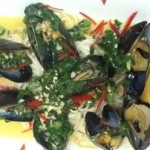Coconut Thai Mussels with Saffron
Ingredients
- 8 oz. Udon (Japanese Noodles)
- 2/3 cup White Wine
- 4-5 Basil , fresh, coarsely chopped
- 24 Mussels debearded and washed
- 3/4 can Coconut Milk lite (13.5 oz can)
- 1/2 cup Water
- 12-14 strands Saffron
- 1 tbsp. Ginger Root grated
- 2 tsp. Red Curry Paste
- 4 Scallions chopped
- 10 oz. Spinach fresh, chopped
- 2 tbsp. Soy Sauce
- 1 tsp. Sesame Oil toasted
- Lime cut into wedges
- 1/2 Red Pepper choppped
Notes
Cook noodles according to directions on package.
In a large sauté pan over medium heat, add wine, garlic and mussels. Bring to a boil.
Add coconut milk, water, saffron, ginger and red curry to pan. Simmer and cook for 3-5 minutes or until all the mussels have opened up.
Add scallions, spinach and cilantro. Cook for about 1 minute.
Finish with soy sauce and sesame oil. Serve over noodles and drizzle with lime juice. Garnish with red pepper and lime wedges. Serve immediately.
This dish was inspired by a recent trip to Chicago were I dined at a fabulous Vietnamese/ French restaurant. I had a bouillabaisse with a coconut saffron sauce. The sauce was delicate and did not over power the seafood. The fresh squeezed lime at the finish of this dish makes it spark. Chef Reed and I collaborated on a recipe that combined these fresh flavors with mussels. Mussels:
Mussels we carry are coming from Prince Edward Island, Canada. Handling Fresh Mussels:
The mussels need to be tightly closed before cooking. They are no longer alive if the shell won’t close. Tap the mussels on the counter and pinch close. If the mussel remains closed, they are ready for cooking. Discard any mussels that won’t close. Scrub the mussels under cold water, removing any of the beard sticking out of the mussel. The beard is a mass of fibers used by the mussel to hang onto rocks. Saffron:
Saffron is the stigmas from a small purple crocus. Each flower only has 3 stigmas. It takes 14,000 stigmas to equal one ounce of saffron. It is a very delicate and labor extensive process, making saffron the world’s most expensive spice. Fortunately, a little saffron goes a long way. Curry:
It is actually a pulverized blend of up to 20 spices, herbs and seeds. Among those most commonly used are: Cardamom, chilies, cinnamon, cloves, coriander, cumin, fennel seed, mace, red and black pepper, saffron, tamarind and turmeric. Curry paste is a blend of clarified butter, curry, vinegar and seasonings. Red curry paste is made with red chilies, while green curry paste is made with green chilies. The green curry paste is usually hotter.
This dish was inspired by a recent trip to Chicago were I dined at a fabulous Vietnamese/ French restaurant. I had a bouillabaisse with a coconut saffron sauce. The sauce was delicate and did not over power the seafood. The fresh squeezed lime at the finish of this dish makes it spark. Chef Reed and I collaborated on a recipe that combined these fresh flavors with mussels. Mussels:
Mussels we carry are coming from Prince Edward Island, Canada. Handling Fresh Mussels:
The mussels need to be tightly closed before cooking. They are no longer alive if the shell won’t close. Tap the mussels on the counter and pinch close. If the mussel remains closed, they are ready for cooking. Discard any mussels that won’t close. Scrub the mussels under cold water, removing any of the beard sticking out of the mussel. The beard is a mass of fibers used by the mussel to hang onto rocks. Saffron:
Saffron is the stigmas from a small purple crocus. Each flower only has 3 stigmas. It takes 14,000 stigmas to equal one ounce of saffron. It is a very delicate and labor extensive process, making saffron the world’s most expensive spice. Fortunately, a little saffron goes a long way. Curry:
It is actually a pulverized blend of up to 20 spices, herbs and seeds. Among those most commonly used are: Cardamom, chilies, cinnamon, cloves, coriander, cumin, fennel seed, mace, red and black pepper, saffron, tamarind and turmeric. Curry paste is a blend of clarified butter, curry, vinegar and seasonings. Red curry paste is made with red chilies, while green curry paste is made with green chilies. The green curry paste is usually hotter.
